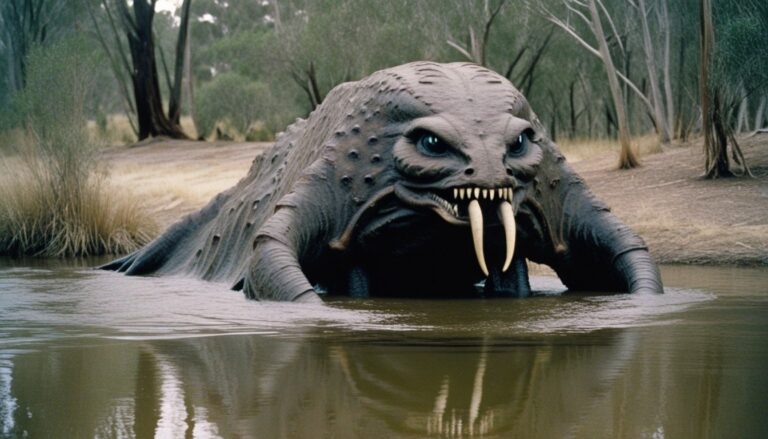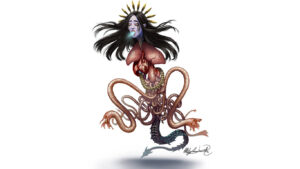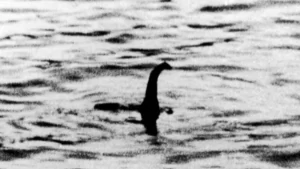Table of Contents
Who is Bunyip
The bunyip is a mythical creature from Australian Aboriginal folklore. Descriptions of the bunyip vary, but it is often said to be a large, water-dwelling creature with characteristics such as a long neck, tusks, flippers, and a loud, eerie cry. Aboriginal stories and beliefs about the bunyip vary among different communities, and the creature is sometimes associated with waterholes, rivers, and other bodies of water.
It’s important to note that the bunyip is a creature from mythology and has not been proven to exist. The stories surrounding the bunyip have been passed down through generations as part of Aboriginal oral traditions. The concept of the bunyip has also become a part of Australian popular culture, and various interpretations and depictions of the creature can be found in literature, art, and media.
Physical Description
The physical descriptions of the bunyip in Aboriginal folklore vary among different communities, and there isn’t a consistent portrayal of its appearance. However, some common features and characteristics associated with the bunyip include:
Size: The bunyip is often described as a large creature, with some accounts suggesting that it is as big as an ox or even larger.
Aquatic Nature: The bunyip is typically associated with water, dwelling in swamps, rivers, billabongs (temporary bodies of water), and other aquatic environments.
Appearance: Descriptions of the bunyip’s appearance vary, but common elements include a long neck, a head with tusks or horns, a horse-like tail, flippers or webbed feet, and sometimes a furry or scaly body.
Sounds: The bunyip is said to emit distinctive and eerie sounds, such as roars, grunts, or cries. These sounds are often attributed to the creature as a means of warning or communication.
The bunyip is a mythical creature, and the descriptions can differ widely based on the specific cultural context and the storyteller’s interpretation. The concept of the bunyip has evolved over time, influenced by both Aboriginal folklore and later popular culture interpretations. Different Aboriginal communities may have their own unique stories and beliefs about the bunyip.
Habitat
The bunyip is traditionally associated with aquatic habitats in Australian Aboriginal folklore. It is said to dwell in various water sources, including swamps, billabongs, rivers, and lakes. The creature is often depicted as being particularly active at night, emerging from the water to roam the surrounding areas.
Different Aboriginal communities may have specific locations or waterholes tied to bunyip stories, and the creature’s presence is often linked to a sense of mystery and fear associated with unknown or hidden aspects of the natural environment.
Special Abilities
In Aboriginal folklore, the bunyip is often described as a mysterious and powerful creature, but specific abilities attributed to the bunyip can vary in different stories. Some accounts suggest the following special abilities:
Stealth and Elusiveness: The bunyip is often depicted as elusive and difficult to spot. It may have the ability to remain hidden in the water or swampy environments, making it challenging for humans to encounter.
Loud and Eerie Sounds: Many bunyip stories emphasize the creature’s ability to produce distinctive and eerie sounds, such as loud roars, cries, or grunts. These sounds may serve as a warning or a means of communication.
Night Activity: The bunyip is often said to be more active at night, venturing out of the water under the cover of darkness. This nocturnal behavior adds to the mysterious and fearsome nature of the creature.
Shape-Shifting or Camouflage: In some variations of bunyip stories, the creature is believed to have the ability to change its appearance or blend into its surroundings. This could make it even more challenging for observers to identify or describe.
Origin
The origin of the bunyip is deeply rooted in Australian Aboriginal folklore. The creature is a part of the oral traditions and stories passed down through generations by various Indigenous communities across Australia. Different Aboriginal groups have their own unique versions of the bunyip myth, and the stories often reflect the cultural, spiritual, and environmental perspectives of the particular community.
The term “bunyip” itself is believed to have originated from an Aboriginal language, and its etymology is not entirely clear. It’s important to recognize that the bunyip is not a single, universally defined creature; rather, it takes on different forms and characteristics in the diverse narratives of different Aboriginal cultures.
The bunyip gained broader recognition in the non-Indigenous Australian population during the 19th century when European settlers and explorers began to encounter and document Aboriginal stories about the creature. The concept of the bunyip also found its way into European-Australian literature and popular culture, contributing to its status as a mythical creature in the broader context of Australian folklore.
While the bunyip remains primarily a figure of Indigenous mythology, its cultural significance has extended beyond traditional storytelling. It has become a symbol of the rich diversity of Aboriginal cultures and their deep connection to the Australian landscape. The bunyip continues to be a subject of interest and inspiration in various artistic and cultural expressions.
Sightings and Fossils
There is no scientific evidence, such as fossils or documented sightings, to support the existence of the bunyip. The bunyip is firmly rooted in Aboriginal mythology and storytelling, and its status as a mythical creature is well-established. The stories about the bunyip are part of the rich cultural heritage of Indigenous Australians, and they have been passed down through generations as part of oral traditions.
Throughout the 19th century, as European settlers explored and settled in Australia, there were occasional reports of mysterious creatures or unusual sounds in remote areas. Some of these reports were attributed to the bunyip by European settlers who may have interpreted their experiences through the lens of Aboriginal folklore. However, these accounts were often speculative, and there was no scientific evidence to support the existence of a large, unknown creature like the bunyip.
In the absence of concrete evidence, the bunyip is widely regarded as a mythical creature. Its depiction in stories and art serves as a cultural and spiritual symbol rather than a zoological reality. It’s important to approach the bunyip as a fascinating aspect of Indigenous Australian folklore and to appreciate its role in cultural narratives rather than as a creature with a scientific basis.
Modern Connotation
In modern times, the bunyip has become more of a cultural and iconic figure rather than a creature believed to exist. It holds a special place in Australian folklore and is often referenced in literature, art, and popular culture. The modern connotation of the bunyip includes:
Cultural Symbolism: The bunyip is recognized as a symbol of Indigenous Australian culture. It represents the diversity of Aboriginal folklore and the connection between Indigenous communities and the Australian landscape.
Literary and Artistic Depictions: The bunyip has made appearances in various works of literature, art, and media. It is sometimes portrayed in children’s books, cartoons, and other creative expressions, contributing to its presence in Australian popular culture.
Tourism and Merchandising: The bunyip has become a part of Australian tourism, with references to the creature appearing in promotional materials, attractions, and merchandise. Some regions play on the bunyip mythology to attract visitors.
Community Events: In some places, there are events and festivals celebrating the bunyip, incorporating the creature into local traditions and activities. These events often highlight the importance of preserving and sharing Indigenous cultural heritage.
Conservation and Environmental Awareness: The bunyip, in a broader sense, is associated with the Australian landscape and water environments. As such, it can be used symbolically in discussions about environmental conservation and awareness.
Bunyip has evolved from a mysterious creature in Indigenous folklore to a cultural symbol that is celebrated and embraced in various ways. It reflects the ongoing efforts to acknowledge and appreciate the richness of Australia’s cultural heritage, particularly that of its Indigenous peoples.
Explanation of the Myth
The myth of the bunyip is deeply rooted in Australian Aboriginal folklore and varies among different Indigenous communities. While specific details may differ, there are common themes in the stories that provide an explanation of the bunyip myth:
Spiritual and Cultural Significance: The bunyip is often regarded as a spiritual being with a connection to the land and water. It may have a role in the cultural beliefs and practices of the Aboriginal communities, serving as a symbol of the mysteries and spiritual forces present in the natural environment.
Guardian of Waterways: In many stories, the bunyip is associated with water sources such as swamps, rivers, and billabongs. It is sometimes considered a guardian or protector of these waterways. The myth may include warnings about respecting waterholes and the consequences of disturbing the bunyip’s habitat.
Teaching Moral Values: Some bunyip stories may have moral or cultural lessons embedded in them. These stories might convey messages about respecting nature, living in harmony with the environment, or passing down traditional knowledge to younger generations.
Creation Stories: In certain Aboriginal cultures, the bunyip may be incorporated into creation myths, explaining the origins of the landscape, animals, or even humans. These creation stories contribute to a cultural understanding of the world and the interconnectedness of all living things.
Explaining the Unknown: The bunyip myth could also serve as a way to explain natural phenomena or mysterious occurrences in the environment. It may provide a narrative framework for understanding aspects of the world that were not easily explained through direct observation.




